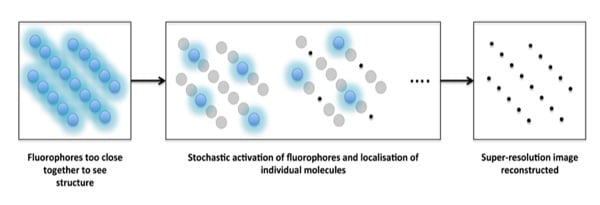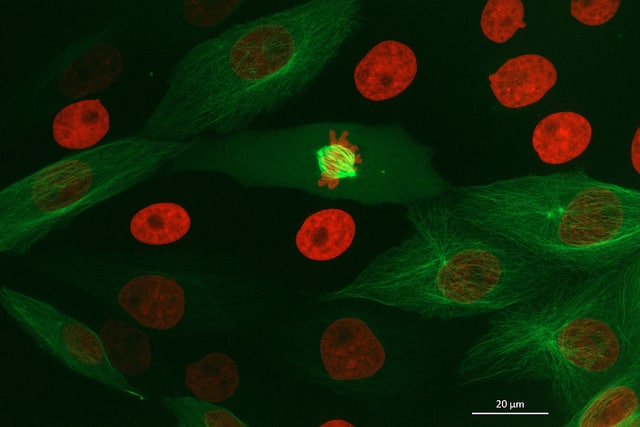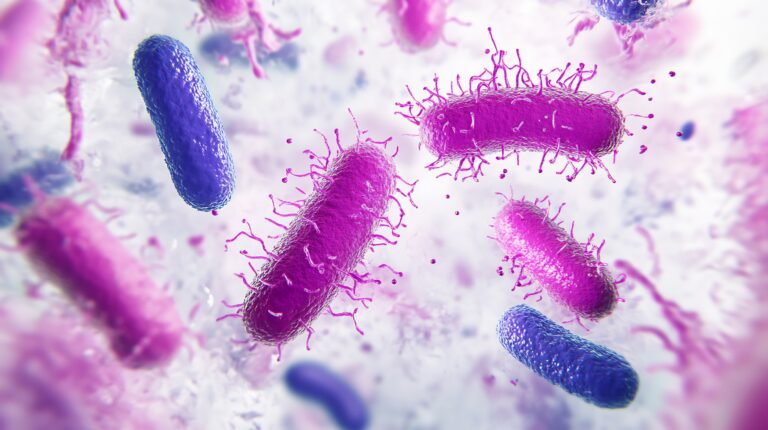Two different sensors are generally used in cameras for microscopy: Charge Coupled Devices (CCD) or Complementary Metal Oxide Semiconductors (CMOS or sCMOS). Although there are a number of similarities between the two sensors, differences in the way they function can have an effect on image capture time as well as signal-to-noise ratio. Let’s take a look at each of these in turn.
Memory from the sixties
Cameras with CCD detectors are still the most widely used in microscopy. These arose from the computer-memory work at the AT&T Labs in 1969. CCD detectors consist of a two-dimensional array of light sensors on a silicon substrate. A photoactive region (capacitor) captures and store light information as electrical charge which is proportional to the light intensity. The detection, digitization and reconstruction of an image is practically simultaneous in CCD cameras.
A global view
CCD cameras generally function in something called ‘Global Shutter’ mode – this means that the whole capacitor array is exposed simultaneously at the same time. Whilst this has an advantage for images which are constantly moving and changing, the main disadvantage come in the frame rate. When the image exposure is complete, each individual pixel is transferred to a single Analogue-to-Digital (A/D) converter – converting the pixel value into a digital value. Consequently, the more pixels which need to be transferred from an image, the slower the frame rate of the camera.
Multiplying the signal
In 2000, Andor Technology developed the Electron Multiplying Charge Coupled Device (EMCCD). Cameras with EMCCD detectors are able to detect single photon events using amplifiers which are able to multiply weak signals without an increase in noise. Their fast speed and low signal-to-noise ratio make EMCCD detectors particularly well suited to fluorescence microscopy.
Enjoying this article? Get hard-won lab wisdom like this delivered to your inbox 3x a week.

Join over 65,000 fellow researchers saving time, reducing stress, and seeing their experiments succeed. Unsubscribe anytime.
Next issue goes out tomorrow; don’t miss it.
CMOS detectors were also developed in the late 1960’s. CMOS cameras utilise many A/D converters – one for each column of pixels which can total many thousands of converters. Instead of transferring each pixel through a single A/D converter, in a CMOS camera the workload is shared between large numbers of A/D converters. You may also come across ‘sCMOS’ or ‘scientific’ CMOS cameras. These are modified to give faster frame rates combined with lower signal-to-noise ratio.
Roll with it
CMOS cameras can function in global shutter mode, however, the array of A/D converters also function in ‘Rolling Shutter’ mode. What this means is that once a row is converted to a digital output, then each row and A/D converter is able to begin the exposure of the next frame. So although the exposure times for each row remain the same, they begin exposing at slightly different times which allows an overlap between two frames. The frame rate in this mode is therefore determined by how quickly the rolling readout process can be completed. In turn, this is determined by the number of rows and the speed of the A/D converters in the array.
Consider the end
If you are at the stage of deciding which camera you should buy for your microscopy research, you need to consider the applications and what images and information you would like to collect from your work.
In general, CCD cameras are better suited for longer exposure times (up to many hours). If you are planning to do in vivo imaging, or capture images from Western Blots for example, then a CCD camera would be your first choice. If you are planning to perform fluorescence imaging on fixed specimens with your camera, then both CCD and CMOS are suited to this application. You can increase the exposure time of a CCD camera as long as your sample is not too sensitive to photobleaching. Alternatively, the sCMOS camera combines low noise, high frame rates and shorter exposure times if you specimen is light sensitive.
Live cell imaging is more sensitive to photobleaching, therefore you need to consider the exposure time needed to capture the images and information you would like for your research questions. For this application, you should take into account the facts that sCMOS cameras have up to 10-times faster frame rate than CCD cameras in conjunction with almost a third less noise than CCD cameras.
If you are constrained to a budget, then CCD cameras are generally more expensive than CMOS cameras. However, you get what you pay for and this means better image quality.
The choice is yours!







